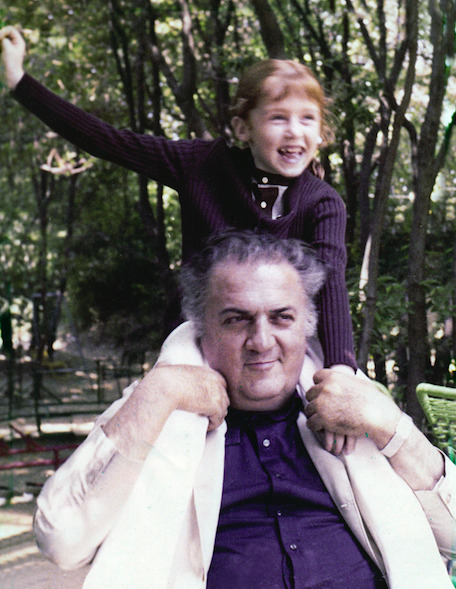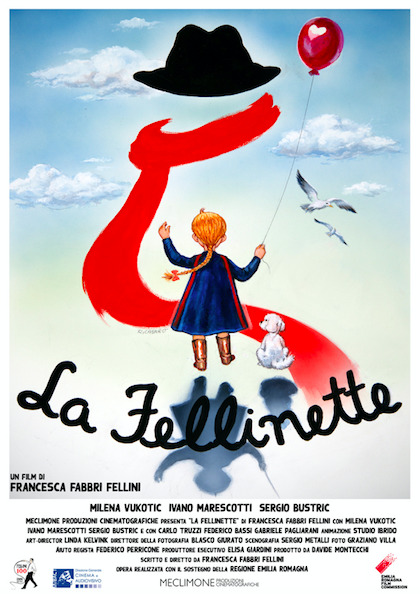
Niece of the great maestro Federico Fellini and daughter of actress Maddalena Fellini and Giorgio Fabbri, Francesca Fabbri Fellini is a film director and critic who hosted a weekly radio programme on the Italian radio station RTL, entirely devoted to cinema.
Her short film La Fellinette, that tributes the oneiric work of her uncle, is part of the programme of the 33rd edition of the Carthage Film Festival in Tunis. The festival is to date the oldest event of its kind still active in Africa, founded in 1966 and often known by the abbreviation JCC, from its French name, Journées cinématographiques de Carthage, or by its Arabic title, أيام قرطاج السينمائية. This year the festival includes in one of its Parallel Sections ‘The World According To Federico Fellini’: a selection of films by or about the great Italian director. This includes three iconic Federico Fellini films: Amarcord, The Voice Of The Moon and Eight And A Half. Four additional films are about his work: Fellini, Fine Mai by Eugenio Cappusio (2019), In The Footsteps Of Fellini (2013) by Gérald Morin, Fellini And The Shadow (2021) by Catherine Mc Gilvray and the animated short film La Fellinnette (2020) by Francesca Fabbri Fellini.
The film directed by Federico Fellini’s niece — released in 2020 to celebrate the 100th anniversary of her uncle’s birth — coalesces animation with dream-like live action, bringing to life the drawing of a little girl that the Italian director had made in 1971.
In this Exclusive Interview, Francesca Fabbri Fellini shares her inspiration in the making of her La Fellinette:

Q: Federico Fellini was known to make many drawings, especially of his dreams, several were included in the publication The Book of Dreams. One of your uncle’s wishes was to make an animation, is this why you decided to animate one of his drawings in La Fellinette?
FFF: I recall I was thinking about what I could do to celebrate his 100th birthday, and one night I dreamt of the little ‘Fellinette,’ the drawing he made for me when I was only six years old, that has kept me company for 51 years. That dream was an animated story. I am convinced that he would have liked this ‘little film,’ as my uncle Chicco would have called it, especially for the way I put his teaching into practice. “Remember Franceschina that we have two lives, one with open eyes and one with closed eyes,” he used to tell me.
Q: Who is the little red-haired girl with the balloon and the white dog?
FFF: I am the little Fellinette. I am the girl with the braided red hair walking on the beach of Rimini with my white poodle Alfie, who unfortunately passed away last year at the age of 17. With this film I gave immortality to my loving playmate.
Q: A great protagonist of your uncle’s films is the city of Rimini, and the same can be said for La Fellinette, set in the wintery seaside of Riviera Romagnola. What is your relationship with Rimini, also seen through your uncle’s eyes?
FFF: “Rimini: a word made up of auctions, of toy soldiers lined up. I can’t objectify. Rimini is a mess, confused, fearful, tender, with this great breath, this open emptiness of the sea; there the nostalgia becomes clearer, especially the winter sea, the white crests, the great wind, as I saw it the first time. It is rather, and only, a dimension of memory. In fact, when I am in Rimini, I am always attacked by ghosts that have already been archived, sorted out.” This is what Federico wrote about Rimini. During the beautiful winter days, we both loved to go for a stroll by the sea and clear our minds. We found it refreshing.

Q: How do you feel contemporary youth differs from the one that Federico Fellini portrayed in his 1953 film I Vitelloni?
FFF: The ‘layabouts’ of the film are nothing but provincial dandies — in Italy during the Fifties they were called ‘GaGà’ for their dainty and refined style. I Vitelloni are spoiled brats, the idlers of the bourgeoisie, common to small and big cities. I believe that ‘vitellonism’ still exists. However, contemporary youth has to face social and economic pressures that are unrelated to previous generations.
Q: What are the three films made by Federico Fellini that represent his style the best, that you feel young people should see?
FFF: “By making films, my aim is to follow this natural inclination, that is, to tell stories with cinema, stories that are congenial to me and that I like to tell in an inextricable mixture of sincerity and invention.” These are the words of Federico Fellini and for me the films that best represent his pursuit are: Eight And A Half, La Dolce Vita, Amarcord.
Q: How was your creative process with Linda Kelvink, at the helm of the animation company Studio Ibrido?
FFF: Linda and her team are a very high quality animation studio.
We worked together a lot in order to give three-dimensionality to the little Fellinette, who was born as a two-dimensional figure. I gave Linda the sketches that my uncle had made for his film The Clowns. But the most wonderful thing that Linda made was the animation of Federico himself, who appears in the finale of my film.
Every time I see him I get goosebumps.
Q: The live action in your film takes place in a very Fellinian setting: the circus. The Paniko circus has a modern concept of this kind of entertainment, what traits do you think corresponded to your uncle’s creative world?
FFF: Indeed, we shot the live action part in a chapiteau of the Circo Paniko, the only original Italian contemporary circus without animals. The crazy trapeze artist, the tall Dane, the hunchback with the metre, the sassy Spaniard: all these characters could have come out of a silent film, they had a Buster Keaton and Samuel Beckett flair that uncle Federico would have liked.
Q: Besides Milena Vukotic — who had already worked with Federico Fellini in Juliet of the Spirits — your cast includes Ivano Marescotti and Sergio Bustric. What Fellinian trait did they possess to be fit for their roles?
FFF: Federico loved Charlie Chaplin. My short film is a silent film. In silent cinema actors had to convey information without using their voice, for this reason, facial expressions, gestures and body movements were very important. My actors were perfect in this.

Q: What was it like to combine the cinematography by Blasco Giurato, the shadow play by Carlo Truzzi, the music score by Andrea Guerra and editing by Simone Felici?
FFF: I had an extraordinary technical cast that made it possible to create a jewel of poetry.
Q: The poster of the film was designed by the great Renato Casaro, what was it like to share your vision with him?
FFF: For me it is a great honour to have the poster designed by an artist like Renato Casaro who is known worldwide. In his poster there is the soul of my film. It was his way of paying homage to Federico, for whom he had never worked.
Q: What does it feel like to be at the Carthage Film Festival, also in the company of other filmmakers who homaged the work of your uncle?
FFF: I have always been attracted by the timeless charm of Tunisia. I’m very excited to be part of the 33rd edition of the JCC, with my La Fellinette, and I am convinced it will be a sensory experience.
Q: What word of advice did Federico give you that you cherish the most?
FFF: “Nothing is known, everything is imagined.”
Check out more of Chiara’s articles.


